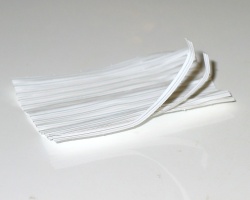How can I reuse or recycle plastic biscuit wrapping?
 I am a fan of biscuits (aka cookies). I have written of my love of biscuits. I am eating a biscuit while writing this. I do try to make my own biscuits but we eat store-bought ones too – and that obviously means packaging waste.
I am a fan of biscuits (aka cookies). I have written of my love of biscuits. I am eating a biscuit while writing this. I do try to make my own biscuits but we eat store-bought ones too – and that obviously means packaging waste.
My favourite shop-bought ones are McVitie’s dark choc digestives so I contacted United Biscuits (who make McVities and a number of other brands) recently about their film-y packaging. They got back to me immediately – which is great compared to most companies – but the news isn’t particular good:
“Packs are made from polypropylene, which is not biodegradable. However, it is recyclable, although I am advised that whilst there are facilities to accommodate this elsewhere, there are currently none in the UK. We are working with the government agencies to try and develop suitable collection in the UK.
Having said that, a lot of work is currently taking place in the packaging community to develop films from sustainable bio sources such as corn. Development of these films may result in biodegradable and compostable films suitable for packaging our products.
The silver layer present in some of our packaging, is a microscopic layer of aluminium used as a barrier to prevent the migration of oxygen into the pack. This increases the shelf life of the product from several days to several months.
We use many hundreds of tonnes of film every year and are very concerned not only by the environment but also by the fact that plastics are derived from a non-renewable resource, crude oil.
Our packaging experts are working with the country’s leading producers to find replacements that are safe, cost effective and environmentally friendly as far as possible.”
Sigh.
So they say it can’t be recycled – what are the other options? Aside from making more at home, I’m careful to bulk buy possible (keeping the excess air-tight to avoid spoilage) but not buy their multipacks, which are the regular packs in an additional plastic pack.
Are there any reuses for polypropylene film? Anyone know of any other recycling avenues to explore?























Polypropylene (PP, recycling code #5) film fuses well and usually makes a nice soft plarn. So one could open out the packages and iron them into sheets for making bags, or cut the packages into strips for knitting or weaving.
There is a very strong environmental arguement against making them at home. Basically it boils down to the comparative inefficiency of home verses manufactured production. You will be saving in some areas, but the overall effect of handmade goods is a negative enviromental effect due to burning more fossil fuels in their production.
That’s a good point – a lot of people forget about the benefits of economies of scale.
But like just about everything, it’s not completely black and white. For example, if my oven is already on because I’m cooking a casserole, adding a tray of biscuits isn’t going to add to my footprint. You’re also assuming that everyone is using fossil fuel-driven cookers – electric ovens could easily be fuelled by renewable energy and, admittedly two corner cases, some people use wood-fuelled ranges or solar ovens for baking at the right time of year.
I think we do need to consider efficiency of cooking though – I asked for suggestions on how to do that a couple of months ago…
I have no problem with your counter arguement, just felt the need to point out factors that should be considered so that when you do use the homemade method it is done where it is most appropriate.
With regards to fossil fuels I stongly advocate research into extraction of Helieum 3 from the Lunar regolith (a payload approximating the cargo capacity of a space shuttle every 6 months would be sufficient to fully replace carbon based fuel dependancy on Earth).
Louisa. I had exactly the same response…word for word…probably taken from the same ‘response to customers’ file. Here is my push back to them.
1. Whilst it is true that 100% PP will not biodegrade, it can be made to biodegrade.
2. You are correct in saying that it is recyclable but there are no facilities to do so. Saying that it is recyclable is therefore not the solution. Working with the government agencies is very good but this will take years to put in place. Flexible packaging waste volumes stood at 840,000 tonnes in 2010. If it takes 10 years to get some recycling facilities in the 398 councils we will have buried 8.4 million tonnes of plastic. The ‘hundreds of tonnes’ you say you use will be part of this and also end up in landfill. You say you ‘are very concerned’ about this which is good.
3. I would challenge that bio films are sustainable. It is billed as ‘sustainable,’ as it is based on food sources, primarily corn. However, if all of the disposable plastic products in the world were made out of corn, 150,000,000 tons of corn would be used to make plastic. Prices for corn would rise dramatically, and third world hunger would increase even more dramatically. There are currently 850,000,000 hungry people in the third world. If we imagine that condition worsening greatly, the result could only be a humanitarian catastrophe of appalling proportions. That is the real ramification of ‘sustainability’ in today’s world.
Furthermore, PLA isn’t a very good plastic. It imparts an off taste to water when used for water bottles, it melts when used as soup spoons, it’s weak, and therefore items made of it are heavy, it has a short shelf life, and it often starts to decay before use, while still on the shelf. What’s more, almost no recyclers accept it for recycling. In fact, recyclers dislike PLA and are trying to ban it, because it gets confused with more conventional plastics, and ruins their recycled plastic batches.
Even commercial composters have a limited appetite for PLA, as it adversely affects the compost batch as too much PLA makes the compost too acidic. Furthermore, PLA cannot be composted by home composters – PLA requires elevated heat beyond what the natural compost process generates to compost.
4. The use of aluminium or metalized films is common place and at present unavoidable.
5. The non-renewable source (oil) is also a concern but most (88%) of the oil extracted from the earth is used as a fuel for transport systems, heating appliances or for the generation of electricity. The amount used for plastics is only 1.5%. A barrel of crude oil has many complex chemicals in it, of various different weights / densities. These various densities are suitable for producing only a limited number of items. ‘Light’ naphtha, the kind used to make plastics, is lighter than gasoline, and denser than natural gas. It has very few uses besides making plastics.
So what is the solution? Your ‘packaging experts are working with the leading experts to find replacements’ – I would very much like to have a conversation with them to discuss a technology that they may have not yet have been exposed to.
There is now a third generation biodegradable product which is the standard plastic we use daily, with an additive that will cause it to biodegrade without the need of heat, UV light, mechanical stress, or oxygen. This third-generation plastic biodegrades when placed into the ground due to the action of micro-organisms naturally occurring in soil. It has all of the benefits of oxo-biodegradable plastics (but not the deficiencies that have recently been exposed) and more – it is recyclable, is invulnerable to water, can have recycled content, it doesn’t diminish the grain supply, and it is stronger, less expensive. It also has the advantage of having the same shelf life as regular plastic, unlike PLA and oxo-biodegradable plastic, as it does not biodegrade until it is in the presence of soil micro-organisms.
Additionally, this new biodegradable plastic will definitely biodegrade when buried in the ground in either aerobic or anaerobic environments, i.e. in a land fill. Like PLA, this new plastic will produce small amounts of methane in a land fill if deeply buried, but not so quickly as PLA, and like PLA, it will produce small amounts of carbon dioxide as a result of the metabolism of micro-organisms if it decomposes in the presence of oxygen.